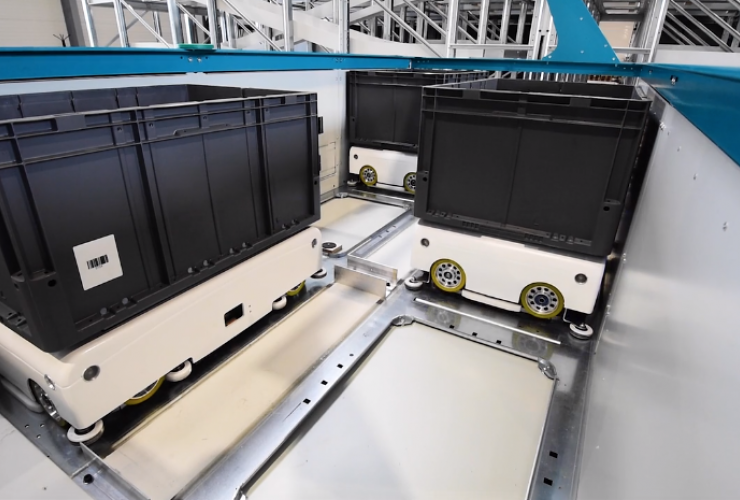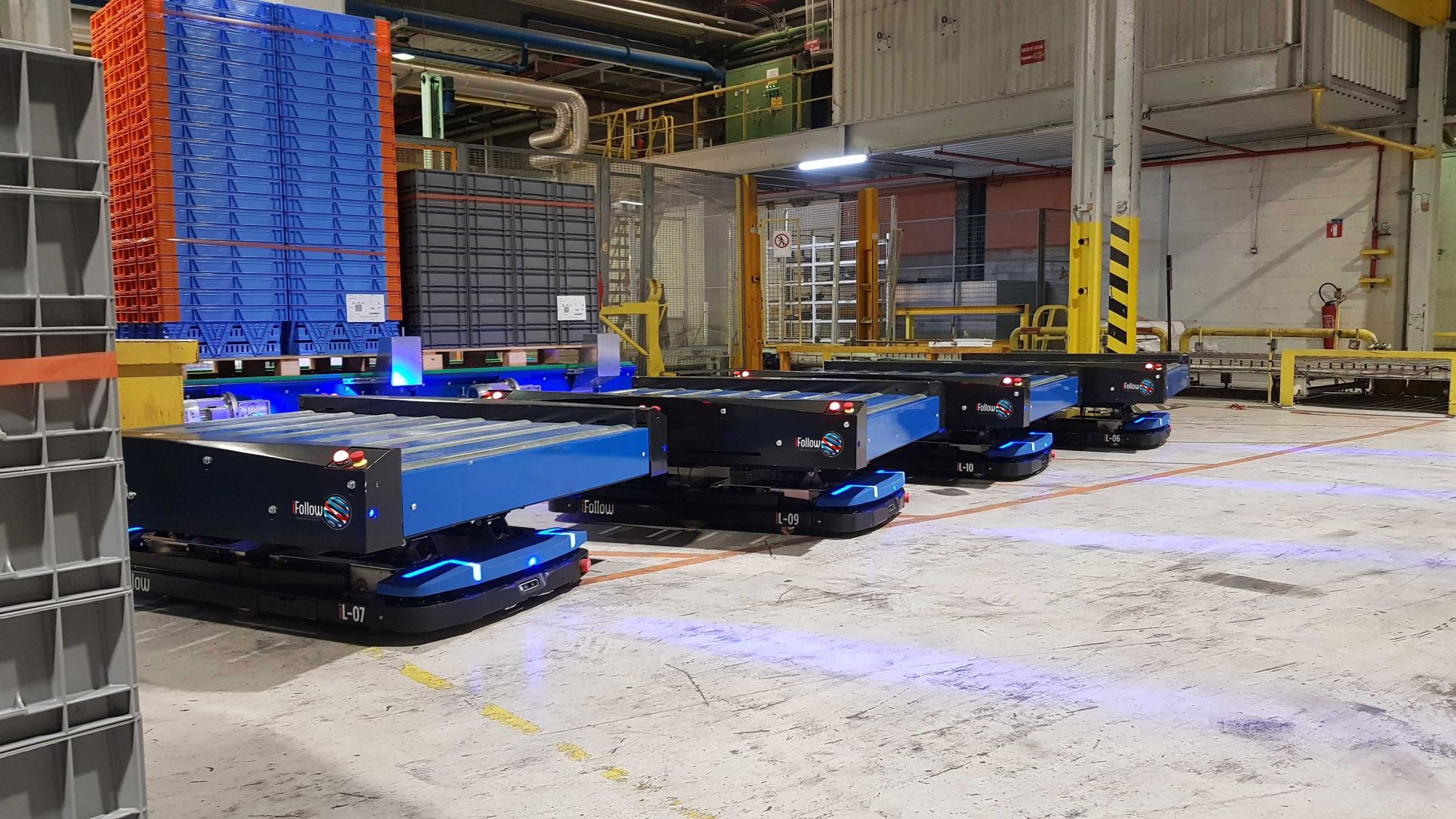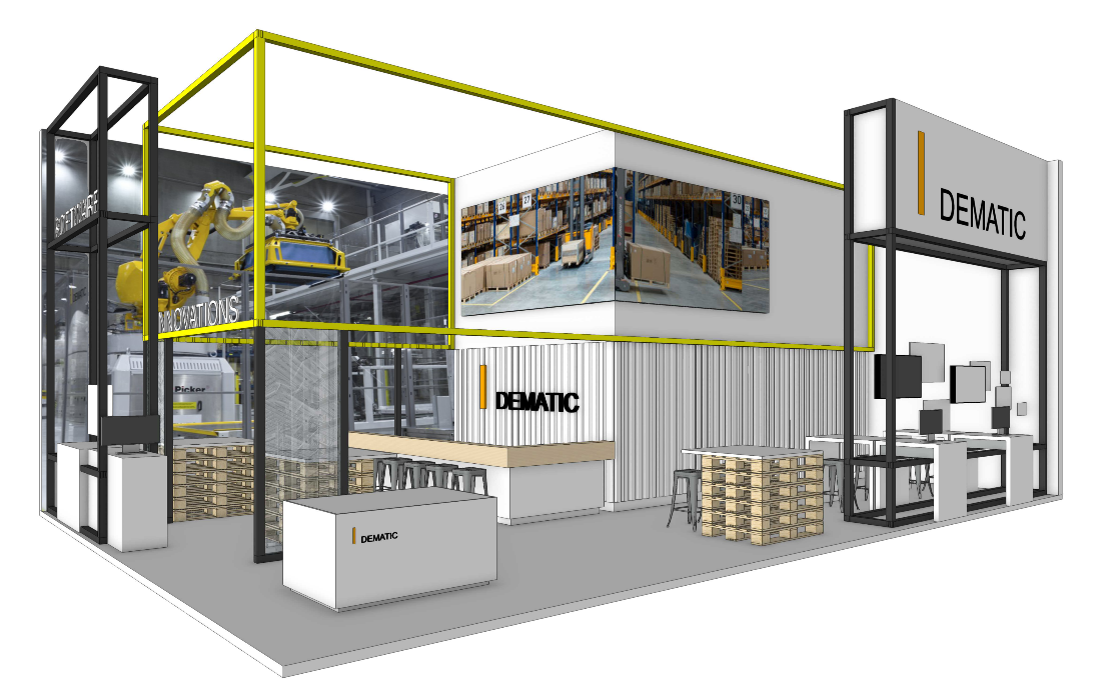The latest product in our series examining each of the IFOY Award nominated finalists ahead of the winners announcement on 30th June at BMW World is the e.scala goods-to-person system entered by Belgian intralogistics specialist stow robotics.
IFOY category: Robot
e.scala is a highly standardised, robot-based goods-to-person system that replaces all the classic components of an automated storage system with a robot and thus enables a realisation time of just three months in addition to a significantly lower investment and lower running costs.
Description
The e.scala is a robot-based storage and order-picking system, whereby the robot moves in three dimensions in a storage cube and can easily reach any point in a warehouse or in production via a rail system. A patented ramp system enables the robots to move from storage level to storage level and to overcome height differences outside the storage cube. Due to the high flexibility of the robots, multiple workstation variants can be mapped very easily. This makes it possible to map almost every procedural customer requirement with standard modules.
The area of application for e.scala is in small and medium-sized installations with a focus on applications in e-commerce, in production supply and on micro-fulfilment solutions. The high level of standardisation of the system makes it possible to automate even small requirements from 500 storage locations and thus enables full automation to be carried out significantly earlier compared to classic systems.
CLICK HERE to watch a video.
IFOY TEST REPORT
The manufacturer stow robotics is coming to the IFOY TEST DAYS in Dortmund with a demo system of a classic goods-to-person shuttle system, which was transported from the truck to the test hall in one go. The only moving part in the storage and picking system is the shuttle that moves on rails, which stow calls “robot”. Otherwise, the customer is supplied with pure redundancy. The strength of e.scala lies where it comes to entry into automation goes.
The USP of the installation is the fact that the complete system consists of only 15 different parts. However, only the “exciting” pre-storage zone is shown with three lines to get to four levels in the warehouse. How the system works is also stored in the product name: The “e” comes from escalator, i.e. an escalator. And the “scala” is intended to demonstrate the scalability. And something else very special is immediately noticeable: the entire installation does not require a vertical lift, i.e. no elevator: the individual aisles are accessed via sloping ramps, which significantly reduces the susceptibility to errors. The module on which the robot can change the direction of travel in order to move the goods to be transported into or out of the warehouse and, with or without goods to be transported, is called the “connector”.
In principle, the system is similar to a multi-storey car park, with the actual ordering system usually being outside the warehouse. The manufacturer attaches great importance to the redundancy of the system: The only thing that can break, according to its own statement, is the robot. But it doesn’t block the whole system. stow uses the 200-year-old concept of the railway. The transport robot has eight wheels: four for driving in the X direction, the other four move the robot in the Y direction after the wheel change. In principle, the entire structure only needs electricity twice: once for the charging station, where the individual robots can charge their power caps – with a charging time of eight seconds, they drive around for around twelve minutes – and once for the WiFi robot communication with the warehouse management system. That also means:
The individual modules of the e.scala system are 5m x 2.5m in size and are scalable. The system still tolerates a total height of 24m. The Stow Traffic Control (STC) knows when the robot drives over the built-in passive RFID tags in the respective section of the route. Some would call it a material flow system, while others would call it a warehouse control system.
e.scala is basically intended for use in small and medium-sized installations with a focus on applications in the e-commerce sector, in production supply and in micro-fulfilment solutions. Because the system is standardized to a high degree, even small requirements from 500 storage locations to be automated can be well served with it. Because the 15 basic components of the system and the robot can be delivered directly from stock, a complete system can be planned and implemented within a very short time. Even in the event of a robot breakdown, the availability of the system is extremely high, because the accessibility of every place in the system is secured at all times via multiple routes.
IFOY Test Verdict
The “charge on the fly” system of the robots, which can recharge their power caps at any time, guarantees customers 100 percent performance of this storage and picking system in 24/7 regular operation. Because for the automation of smaller systems, low initial investments and a later easy scalability are of great importance, e.scala is perfect for SMEs that don’t want to go “full” with their investment in automated intralogistics.
IFOY INNOVATION CHECK
Market relevance: With e.scala, Stow robotics is targeting small and medium-sized container-based warehouse automation solutions based on the goods-to-person principle, which are currently in particularly high demand in the growth sectors of e-commerce, micro-fulfilment and production supply. Economical use should already be possible from 500 storage locations or 250 square meters of floor space. e.scala has to compete with systems from Autostore and Exotec in this area. Market potential and relevance are expected to be high due to the special features of the system.
Customer benefit: The ramp system for changing the robots between the storage levels makes it possible to dispense with lifts, rigid conveyor technology and electrification of the storage area and thus achieve low system complexity with low investment, operating and maintenance costs. The standardization allows rapid implementation and commissioning within just three months. The storage cube can be scaled quite freely in terms of height, width and length and allows a certain degree of flexibility when choosing between storage density and capacity. The advantages over AutoStore are the higher payload, faster response time, higher throughput and better redundancy. In certain configurations, even higher storage densities should be achievable.
Novelty: The innovation consists above all in the low system complexity caused by the use of the ramps. The robots are the only actuated units in the storage structure, which makes the solution extremely scalable at a moderate cost. In addition, there is increased redundancy since each container in the system can be reached via multiple paths. Containers can be flexibly sequenced at three points in the system, but this is not an innovation compared to other systems. The charging management of the robots is excellently solved by supercaps, which are quickly charged during the picking process in 8 seconds for 12 minutes of operating time, which ensures that the robots are available 24 hours a day.
Functionality / type of implementation: The functioning of the test system was successfully demonstrated. The robot with two-way chassis changed storage levels safely with and without a load via the ramps. Apart from the integrated lifting function for picking up the boxes, the robots are kept simple and robust. Using the rail system, the robots can also carry out sequencing in the pre-zone and drive to other areas of the building for production supply.
Verdict: The specific customer benefit of e.scala is given above all for small and medium-sized systems, which are to be implemented quickly and cost-effectively due to the simplicity and standardization of the solution. The system is technically simple and solidly built and impresses with its flexibility in choosing between storage density and performance as well as with the comparably high level of redundancy even if individual robot units fail.
market relevance ++
customer benefit +
novelty +
functionality / type of implementation ++
[++ very good / + good / Ø balanced / – less / – – not available]
For an overview of all the finalists, visit www.ifoy.org
CLICK HERE to find out more about stow robotics’ e.scala solution.











